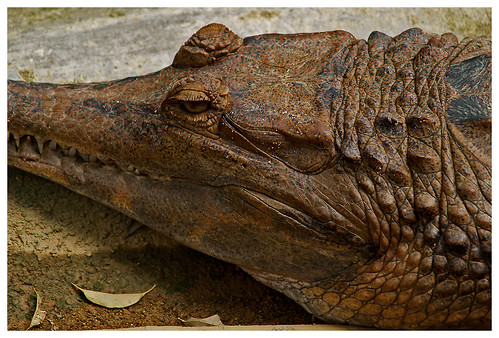REPTOgraphy
Dinosaurs are giant fossilized reptiles - there there are still 6,800 reptile species on earth left. The major groups are alligators and crocodiles, turtles, lizards, and snakes. All reptiles are cold-blooded, which is why they warm themselves in the sun, and have bodies covered in dry, horny scales. Some reptiles lay eggs; others give birth to live young. In general, lizards have a small head, short neck, and long body and tail. And unlike snakes, most lizards have moveable eyelids.
Pokqour
I was told this lizard species is called pokqour. Full name is pokqour hangok. The skin tone can easily adapt to the surrounding colors. So there is nothing wrong with the white-balance here, isn't it?.

"Kelantanese Pokqour" - ZD 70-300mm f4.0/5.6 @300mm f11 1/180secs ISO200
All "pokqours" or chameleons species are able to change their skin colour. Chameleons change their colour in response to light exposure and ambient temperature.
Different chameleon species are able to change different colours which can include pink, blue, red, orange, green, black, brown and yellow. Chameleons are naturally coloured for their surroundings as a camouflage. However, recent research has indicated that Chameleons may use colour changes as a method of communication, including to make themselves more attractive to potential mates.
Chameleons have specialized cells, collectively called chromatophores, that lie in layers under their transparent outer skin. The cells in the upper layer, called xanthophores and erythrophores, contain yellow and red pigments respectively. Below these is another layer of cells called iridophores or guanophores, and they contain the colourless crystalline substance guanine. These reflect, among others, the blue part of incident light. If the upper layer of chromatophores appears mainly yellow, the reflected light becomes green (blue plus yellow). A layer of dark melanin containing melanophores is situated even deeper under the reflective iridophores. The melanophores influence the 'lightness' of the reflected light. All these pigment cells can rapidly relocate their pigments, thereby influencing the colour of the chameleon.
Crocodile
Crocodiles are ambush hunters, waiting for victims to come close to attack. They can survive long periods without food, and rarely need to actively go hunting. The crocodile's bite strength is up to 3,000psi about 10 times comparing to just 350psi for a large shark. Despite their slow appearance, crocodiles are top predators in their environment.

The one shown above is commonly known "Cupram Crocodilus", may be due to the skin tone looks like copper. Perfect-tan skin for handbags, but must remember that "when buying stops, the killing can too"
This page is UNDER CONSTRUCTION, please proceed to the following galleries:
HOMEpage
Pokqour
I was told this lizard species is called pokqour. Full name is pokqour hangok. The skin tone can easily adapt to the surrounding colors. So there is nothing wrong with the white-balance here, isn't it?.

"Kelantanese Pokqour" - ZD 70-300mm f4.0/5.6 @300mm f11 1/180secs ISO200
All "pokqours" or chameleons species are able to change their skin colour. Chameleons change their colour in response to light exposure and ambient temperature.
Different chameleon species are able to change different colours which can include pink, blue, red, orange, green, black, brown and yellow. Chameleons are naturally coloured for their surroundings as a camouflage. However, recent research has indicated that Chameleons may use colour changes as a method of communication, including to make themselves more attractive to potential mates.
Chameleons have specialized cells, collectively called chromatophores, that lie in layers under their transparent outer skin. The cells in the upper layer, called xanthophores and erythrophores, contain yellow and red pigments respectively. Below these is another layer of cells called iridophores or guanophores, and they contain the colourless crystalline substance guanine. These reflect, among others, the blue part of incident light. If the upper layer of chromatophores appears mainly yellow, the reflected light becomes green (blue plus yellow). A layer of dark melanin containing melanophores is situated even deeper under the reflective iridophores. The melanophores influence the 'lightness' of the reflected light. All these pigment cells can rapidly relocate their pigments, thereby influencing the colour of the chameleon.
Crocodile
Crocodiles are ambush hunters, waiting for victims to come close to attack. They can survive long periods without food, and rarely need to actively go hunting. The crocodile's bite strength is up to 3,000psi about 10 times comparing to just 350psi for a large shark. Despite their slow appearance, crocodiles are top predators in their environment.

The one shown above is commonly known "Cupram Crocodilus", may be due to the skin tone looks like copper. Perfect-tan skin for handbags, but must remember that "when buying stops, the killing can too"
This page is UNDER CONSTRUCTION, please proceed to the following galleries:
Categories
ARACHNOgraphy - spiders
ENTOMOgraphy - insects
FLORAgraphy - flowers
LEPIDOgraphy - butterflies and moths
MAMMALgraphy - four-legged animals
WONDERcolors - natural spectrum of colours
Uncategorised photos
ANYphoto - general uncategorised photos
CLOSEUPhotography - general close-up photos [non-macro]
TALKphotography - readers can find FAQ, post questions and comments here
WONDERcolors - striking color photosHOMEpage





